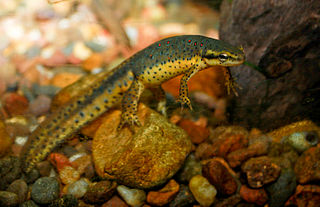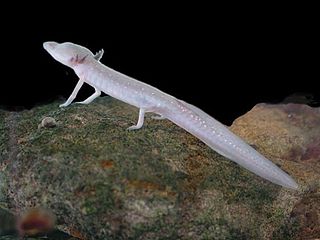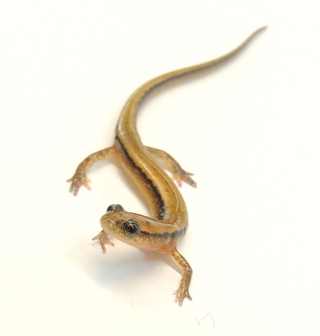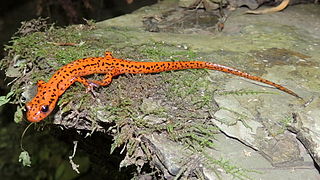
Amphibians are four-limbed and ectothermic vertebrates of the class Amphibia. All living amphibians belong to the group Lissamphibia. They inhabit a wide variety of habitats, with most species living within terrestrial, fossorial, arboreal or freshwater aquatic ecosystems. Thus amphibians typically start out as larvae living in water, but some species have developed behavioural adaptations to bypass this.

Plethodontidae, or lungless salamanders, are a family of salamanders. Most species are native to the Western Hemisphere, from British Columbia to Brazil, although a few species are found in Sardinia, mainland Europe south of the Alps, and South Korea. In terms of number of species, they are by far the largest group of salamanders.

The eastern newt is a common newt of eastern North America. It frequents small lakes, ponds, and streams or nearby wet forests. The eastern newt produces tetrodotoxin, which makes the species unpalatable to predatory fish and crayfish. It has a lifespan of 12 to 15 years in the wild, and it may grow to 5 in (13 cm) in length. These animals are common aquarium pets, being either collected from the wild or sold commercially. The striking bright orange juvenile stage, which is land-dwelling, is known as a red eft. Some sources blend the general name of the species and that of the red-spotted newt subspecies into the eastern red-spotted newt.

Brook salamanders are a genus, Eurycea, of salamanders native to North America.

The Texas blind salamander is a rare and endangered cave-dwelling troglobite amphibian native to San Marcos, Hays County, Texas, specifically the San Marcos Pool of the Edwards Aquifer. This species resembles the olm, another stygofaunal salamander from Europe. Unlike the olm, this amphibian's body is not as elongated, and also has less reduced digits on its limbs.

The Santa Cruz long-toed salamander is an endangered subspecies of the long-toed salamander, which is found only close to a few isolated ponds in Santa Cruz and Monterey Counties in California. It has a black body, broken yellow or orange irregular striping along its spine, and a tail fin well evolved for swimming. Like other mole salamanders, it is found near pools or slow-moving streams and has a very secretive lifestyle, making it difficult to find.

The marbled salamander is a species of mole salamander found in the eastern United States.
The northern banana salamander, also known as common dwarf salamander or rufescent salamander, is a species of salamander in the family Plethodontidae. It is found in the Atlantic slopes of Meso-America from San Luis Potosi, Veracruz, and northern Chiapas in Mexico continuing on to the southern part of Guatemala, Belize, and northern Honduras. However, its range south of Mexico is uncertain because the records may refer to other species.

Desmognathus fuscus is a species of amphibian in the family Plethodontidae. The species is commonly called the dusky salamander or northern dusky salamander to distinguish it from populations in the southern United States which form several distinct species, the southern dusky salamanders. The northern dusky salamander is the most widespread representative of its genus in Canada. It can be found in eastern North America from extreme eastern Canada in New Brunswick south to South Carolina. The size of the species' total population is unknown, but is assumed to easily exceed 100,000. The species' habitat differs somewhat geographically; dusky salamanders in the northern part of the range prefer rocky woodland streams, seepages, and springs, while those in the south favor floodplains, sloughs, and muddy places along upland streams. They are most common where water is running or trickling. They hide under various objects, such as leaves or rocks, either in or near water. Alternatively, they may enter burrows for protection. The dusky salamander lays its eggs close to water under moss or rocks, in logs, or in stream-bank cavities. The larval stage which follows is normally aquatic.

The ocoee salamander is a species of salamander in the family Plethodontidae. This salamander has a variety of colors and patterns, and got its name from Tennessee state wildflower. Its natural habitats are temperate forests, rivers, intermittent rivers, freshwater springs and wet rocks in mountainous areas of the Southeastern United States. It was first described by Nicholls in 1949. They are territorial and feed on small invertebrates. It is widely distributed in the southeastern United States and is listed as "Least Concern" by the International Union for Conservation of Nature.

The pygmy salamander is a species of salamander in the family Plethodontidae. It is endemic to the United States in the southern Appalachians in North Carolina and Tennessee. Desmognathus wrighti is a member of the family Plethodontidae and is commonly known as the pygmy salamander. As the name suggest the pygmy salamander is the smallest of the nineteen species in the genus Desmognathus. D. wrighti undergoes direct development and does not have a free-living larval stage. Only two other taxa in Desmognathus, D. aeneus and D. organi, exhibit direct development along with the pygmy salamander. In the genus Desmognathus, body size, habitat preferences, and patterns used by males during courtship are quite variable. D. wrighti courtship is noted by the male biting and seizing its partner in order to provide them with a chemical stimulus. The pygmy salamander can be found in the southern Appalachians of the United States in western North Carolina and eastern Tennessee. Geographical distribution of the Desmognathus wrighti is fragmented and the highest abundance of the species can be found at high elevations in spruce and fir tree forest.

The southern two-lined salamander is a species of salamander in the family Plethodontidae, endemic to the United States. Its natural habitats are temperate forests, rivers, intermittent rivers, swamps, and freshwater springs.

The Junaluska salamander is a species of lungless salamander native to the south-eastern United States. It was first described by David M. Sever, Harold M. Dundee, and Charles D. Sullivan who found the species in the range from the Cheoah River, Santeetlah Creek, and Tululah Creek in Graham County of North Carolina. Adults of this species can be found near large, rocky streams and on rainy nights on roads in the areas specified. The salamander is characterized by brownish-yellow coloration with a series of small dots along the body and a robust build compared to the other salamanders in Eurycea. The Junaluska salamander's breeding habits tend to be in large streams where the eggs are laid and attached to the bottom of rocks in the streams where they are found. According to the overall conservation listing for IUCN, this species is listed as Vulnerable. Conservation acts are important in both North Carolina and Eastern Tennessee, since the population of this species in each state is so small.

The Blue Ridge two-lined salamander is a species of salamander in the family Plethodontidae, endemic to the United States. This species is found in the southern Appalachian Mountains, mostly south of Virginia. To the north is a similar salamander, Eurycea bislineata, or the northern two-lined salamander. Its genus, Eurycea contains 33 species and includes taxa that have either a metamorphic life cycle or larval-form paedomorphosis. In species that metamorphose, there can be within-and among-population variation in larval life-history characteristics, e.g., duration of the larval period and size at metamorphosis. Intraspecific geographic variation in species of Eurycea has been attributed to several factors: temperature, stream order and productivity of the larval habitat.

The spring salamander is a species of salamander in the family Plethodontidae. It is found in Canada and the United States. The genus, Gyrinophilus, means "tadpole lover" and refers to the long period of time it spends as a gilled larva before maturing. The specific epithet, porphyriticus, is Latin from Greek, meaning the color of porphyry, a purple stone, and this salamander has also been called the purple salamander.

The red salamander is a species of salamander in the family Plethodontidae endemic to the eastern United States. Its skin is orange/red with random black spots. Its habitats are temperate forests, small creeks, ponds, forests, temperate shrubland, rivers, intermittent rivers, freshwater, trees springs. Overall this species is common and widespread, but locally it has declined because of habitat loss and it is considered threatened in Indiana. Red salamanders eat insects, earthworms, spiders, small crustaceans, snails, and smaller salamanders. To eat, they extend their tongue to capture prey on the tip of it and retract it back into their mouths. The red salamander, as a member of the family Plethodontidae, lacks lungs and respires through its skin.

The green salamander is a species of lungless salamander in the family Plethodontidae. It and the Hickory Nut Gorge green salamander are the only currently-described members of the genus Aneides that inhabit any areas in the eastern half of United States. Rarely seen in the field, the green salamander is an extremely habitat-specific species that is seldom found away from its preferred surroundings: moist, shaded rock crevices.

The spotted-tail salamander, also known as a "cave salamander", is a species of brook salamander.
The brownback salamander is a species of brook salamander. Its range includes parts of Alabama, Georgia, and Tennessee, where it occurs in natural freshwater springs typically abundant in watercress. Once considered an ecotype of the southern two-lined salamander, the brownback salamander was subsequently raised to full species status based on molecular evidence.
The Carolina Sandhills salamander, is a species of lungless salamander endemic to the state of North Carolina in the United States, where it is only found in the Sandhills region. These species are known for their coloration and ecology. Researchers decades ago separated the species into northern and southern groups and found that the southern and northern Sandhill salamanders differ in coloration, size, and natural history.



















